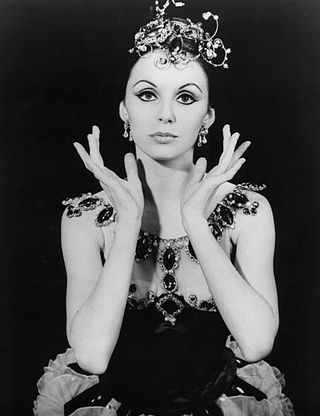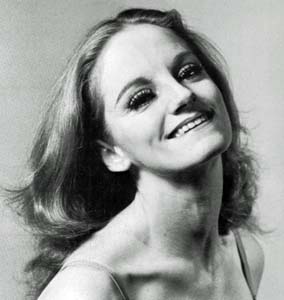Related Research Articles

Darci Kistler is an American ballerina. She is often said to be the last muse for choreographer George Balanchine.

Violette Verdy was a French ballerina, choreographer, teacher, and writer who worked as a dance company director with the Paris Opera Ballet in France and the Boston Ballet in the United States. From 1958 to 1977 she was a principal dancer with the New York City Ballet where she performed in the world premieres of several works created specifically for her by choreographers George Balanchine and Jerome Robbins. She was Distinguished Professor of Music (Ballet) at the Jacobs School of Music, Indiana University, in Bloomington, and the recipient of two medals from the French government.

Stars and Stripes is a neoclassical ballet choreographed by George Balanchine to music by John Philip Sousa, orchestrated by Hershy Kay. The ballet was made as a tribute to the United States, Balanchine's adopted country. It premiered on January 17, 1958, at the City Center of Music and Drama, danced by the New York City Ballet. It is dedicated to Fiorello La Guardia, former mayor of New York City. The ballet had been revived by multiple ballet companies, and at different special occasions.

Patricia McBride is a ballerina who spent nearly 30 years dancing with the New York City Ballet. McBride joined the New York City Ballet in 1959. She became a principal in 1961, becoming the company's youngest principal. She danced with the company for 30 years, including roles created for her by choreographers George Balanchine and Jerome Robbins.
Miriam Mahdaviani is a choreographer, a former New York City Ballet dancer and a repetiteur for the George Balanchine Trust. She has created ballets for NYCB's 1988 American Music Festival and its Diamond Project in 1992, 1994,1997, 2000 and 2002. She also choreographed ballets for Pacific Northwest Ballet, Richmond Ballet, Jacob's Pillow, Vassar College, NYU Tisch School of the Arts, SUNY Purchase, and others. Internationally, her ballets have been presented at MaggioDanza in Florence, Italy and at the Edinburg Festival in Scotland.
Yvonne Borree is a former principal dancer at New York City Ballet. She was raised in Norfolk, Virginia, where she began her dance studies with the Tidewater Ballet Association at four years of age.
Kyra Nichols is an American retired ballet dancer and teacher. She joined the New York City Ballet in 1974 and was promoted to principal dancer in 1979. She is one of the last dancers to have worked with George Balanchine, although he did not create any new work on her. However, she originated roles in several ballets by Jerome Robbins. Nichols retired from performing in 2007, after a 33-year career.

Karin Anny Hannelore Reinbold von Aroldingen was a German ballet dancer. She danced as a soloist at the Frankfurt Opera Ballet before joining the New York City Ballet in 1962 after receiving a personal invitation from George Balanchine. She was named as one of Balanchine's main beneficiaries in his will. Von Aroldingen retired from New York City Ballet in 1984, having reached the rank of principal dancer in 1972. In her later life, she worked as a répétiteur for the Balanchine Trust, for which she was also a founder, staging his ballets for various companies.
Miranda Weese is an American former ballet dancer, teacher and ballet master. She joined the New York City Ballet in 1993 and was promoted to principal dancer in 1996. In 2007, she left to perform with the Pacific Northwest Ballet, first as a guest artist, then joined the company as a principal dancer, before retiring in 2010. In 2017, she joined the Boston Ballet as a children's ballet master.

Kay Mazzo is an American former ballet dancer and educator. In 1961, she joined Jerome Robbins' company, Ballets USA. The following year, she joined the New York City Ballet and was promoted to principal dancer in 1969. She created roles for George Balanchine and Robbins, before retiring from performing in 1981. She then joined the permanent faculty of the School of American Ballet in 1983, named co-chairman of faculty in 1997 and chair of faculty in 2018. She stepped down from the position in June 2022, but continues to teach.
Vienna Waltzes is a ballet choreographed by George Balanchine to music by Johann Strauss II, Franz Lehár and Richard Strauss, made as a tribute to Austria. It premiered on June 23, 1977 at the New York State Theater, performed by the New York City Ballet, and was an immediate success among the public.
Liebeslieder Walzer is a two-part neoclassical ballet choreographed by George Balanchine to Johannes Brahms' Liebeslieder Waltzes, Op. 52 and Neue Liebeslieder, Op. 65, with original sets and lighting designed by David Hays, and costumes designed by Barbara Karinska. The ballet premiered on 12 November 1960 at the New York City Center, performed by the New York City Ballet.
Ballo della Regina is a ballet choreographed by George Balanchine. Set to the ballet divertissement from Giuseppe Verdi's opera Don Carlos, the Balanchine ballet is plotless but alludes to the grotto setting of the divertissement. The ballet is danced by a lead couple and an all-female ensemble, with choreography that showcases the speed and precision of the lead ballerina. Ballo della Regina was made for the New York City Ballet, and premiered on January 12, 1978, at the New York State Theater, with Merrill Ashley and Robert Weiss in the two lead roles.

Sally Harrington, known professionally as Sara Leland, was an American ballet dancer and répétiteur. She started her career with the Joffrey Ballet in 1959, and was recruited to join the New York City Ballet by George Balanchine in 1960. She was promoted to principal dancer in 1972, and created roles for both Balanchine and Jerome Robbins.
Nina Vladimirovna Vyroubova was a Russian-born French ballerina, considered one of the finest of her generation.
Stephanie Renee Dabney was an American dancer who performed as a prima ballerina with Dance Theatre of Harlem from 1979 through 1994. Dabney is best known for her performances in John Taras' The Firebird, which she performed all over the world, as well as at the opening ceremony of the 1984 Summer Olympics in Los Angeles.

Judy Elizabeth Tyrus is a classical ballet dancer who danced as a principal with the Dance Theatre of Harlem (DTH) from 1977 to 1999. She was the curator and an archivist for DTH for over eleven years. She founded ChromaDiverse, Inc., a non-profit company supporting arts, culture and theatre causes in May 2019.
Margaret Tracey is an American ballet dancer and educator. She joined the New York City Ballet in 1986, was promoted principal dancer in 1991, and retired in 2002. She served as the director of the Boston Ballet School between 2007 and 2021.
Maria Calegari is an American ballet dancer, teacher and répétiteur. She joined the New York City Ballet in 1974 and became a principal dancer in 1983. She left the company in 1994, then occasionally performed until 2004. She also teaches ballet and began working as a répétiteur for the Balanchine Trust and Robbins Rights Trust in 1996 and 2003 respectively.
References
- 1 2 3 4 5 Sillman, Marcie (March 7, 2018). "Balanchine Protégée Stephanie Saland Helps Dancers Connect With Their Desire to Move". Dance Teacher.
- 1 2 3 4 5 Van Gelder, Lawrence (November 12, 1978). "How a Computer Created a Ballerina". The New York Times.
- 1 2 3 4 5 6 7 8 Serchuk, Barnett (February 11, 2014). "BWW Interviews: Stephanie Saland". BroadwayWorld.
- ↑ "City Ballet Promotes Several Dancers". The New York Times. June 11, 1984.
- ↑ Kisselgoff, Anna (January 14, 1978). "City Ballet Presents the Premiere Of Balanchine 'Ballo della Regina'". The New York Times.
- ↑ Kisselgoff, Anna (May 18, 1980). "Ballet: Balanchine's 'Walpurgisnacht'". The New York Times.
- ↑ Anderson, Jack (December 2, 1986). "The Dance: City Ballet". The New York Times.
- ↑ Anderson, Jack (January 22, 1988). "City Ballet: 'Jewels'". The New York Times.
- ↑ Kisselgoff, Anna (May 6, 1978). "New York City Ballet Presents Night Marked by Major Debuts". The New York Times.
- ↑ Anderson, Jack (June 4, 1984). "Review/Ballet; Nuances and Innuendos Of 'Liebeslieder Walzer'". The New York Times.
- ↑ Anderson, Jack (June 18, 1984). "Dance:The City Ballet Displays Its Diversity". The New York Times.
- ↑ Kisselgoff, Anna (June 22, 1979). "Dance: Baryshnikov in 'Sonnambula'". The New York Times.
- ↑ Anderson, Jack (June 2, 1983). "City Ballet: Balanchine Davidsbundlertanze". The New York Times.
- ↑ Kisselgoff, Anna (July 3, 1979). "Ballet: 'Square Dance'". The New York Times.
- ↑ Dunning, Jennifer (May 28, 1993). "Review/City Ballet; Balanchine Unlike Himself". The New York Times.
- ↑ Anderson, Jack (February 22, 1993). "Dance in Review". The New York Times.
- ↑ Anderson, Jack (February 11, 1979). "Miss Saland Is Swanilda in 'Coppélia'". The New York Times.
- ↑ "Stephanie Saland Dances 'Nutcracker'". The New York Times. January 5, 1976.
- ↑ "City Ballet Schedules A Robbins Premiere". The New York Times. January 28, 1984.
- ↑ Kisselgoff, Anna (January 20, 1979). "Robbins's 'Four Seasons' Given Debut by City Ballet". The New York Times.
- ↑ Kisselgoff, Anna (January 16, 1975). "The Dance: Sheer Ballet". The New York Times.
- ↑ Anderson, Jack (January 22, 1985). "The Dance: City Ballet Revives 'In the Night'". The New York Times.
- ↑ Perron, Wendy (February 28, 2017). "How to Nail the Mad Ballerina Role in Robbins' Funniest Ballet". Dance Magazine.
- ↑ Kisselgoff, Anna (February 2, 1980). "The Dance: City Ballet Presents 'Fancy Free' by Robbins". The New York Times.
- ↑ Dunning, Jennifer (February 8, 1993). "Dance in Review". The New York Times.
- ↑ Dunning, Jennifer (January 7, 1984). "Ballet: 'Goldberg Variations'". The New York Times.
- ↑ Kisselgoff, Anna (June 29, 1993). "Review/City Ballet; Balanchine on the Menu: Dances, Friends and Food, Food, Food". The New York Times.
- ↑ Greskovic, Robert (2005). Ballet 101: A Complete Guide to Learning and Loving the Ballet. p. 584. ISBN 9780879103255.
- ↑ Berardi, Gigi (July 1, 2006). "Stephanie Saland teacher's wisdom". Dance Magazine.